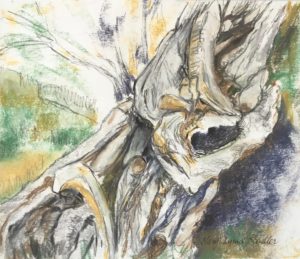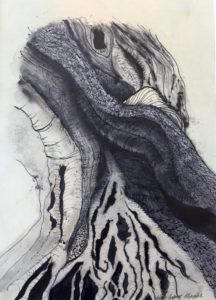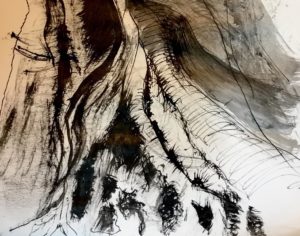We are over the moon to be able to share with you the first of three winning blog entries, from our small business support group challenge.
Written by Artist and Writer, Mary-Lynne Stadler, this is…
Textures of Time
‘The subject chooses you. Then your job is to make the thing well-wrought so that you give it shape, you give it form.’ (Tom Fairs, Artist)
What happened when I first saw the ancient olive tree that became my new muse just as we moved into a new year was exactly that – the subject choosing me. Her arrival (yes, for some reason I think of her as feminine) was very timely. I had been yearning for something that would truly inspire me for quite a while, and nothing had really sparked my fire.
Until the moment that I first saw her. It was a moment of recognition, and I knew that she and I had work to do together. I knew I needed to get to know her better, but how was I going to be able to fulfil my brief, the challenge of making the work well-wrought, as Tom puts it, so as ‘to awaken in another the sensibility of what has been experienced,’ and ‘not communicating bits of information.’
Therein lies the challenge. Always.
I needed to understand my own experience first, and started to think about it. How was I going to be able to convey the sense of awe that came over me when I first saw her? How do you describe the instant you first set eyes on someone and have a flash of knowing that you have an intangible connection, that you have fallen in love? It’s hard enough to find words to describe those feelings. How to do it visually?
You can read about those first reactions in my earlier blog.
As I have immersed myself in the work it has gradually dawned on me that there is a lot of love in that old tree. When you look at her from one particular angle – the one that immediately struck me that day of our first meeting – you see a heart, defined and embraced by her old bent and broken branches. Despite the ravages of centuries that have scarred her, she still has a warm and embracing heart that still beats with life.
She has lived through hundreds of years of winds and floods and droughts. She has weathered storms and diseases, as well as interventions by insects, and humans and animals. Every one of those experiences has been scored, more or less deeply, in every fibre, every creeping root and every one of her broken branches, and each one has left its individual mark.
So I have been continuing to deepen my relationship with this tree by looking more closely at the many textures that have been etched on her over time. My thinking is that one way that I could portray the passage of time would be through different kinds of marks, and the mediums chosen to make them.

Gnarled and twisted.
Chalk pastel and Charcoal
This was one of my first texture studies. I used chalk pastels in grey, yellow ochre, raw umber, green and deep indigo to create the lights and shades, and charcoal to define shapes and direction.
I had some fine Chinese paper that had previously been stained with printing inks when I had been doing some mono-printing. It had inherently interesting texture and colour variations. I did a quick mono-printed sketch of one of my original drawings of the tree on it, then added volume and emphasised the movement of its branches with chalk pastel in tones of grey. The rough texture of the dried ink on the paper offered up an interestingly uneven tooth to catch the chalk and give an aged appearance. Charcoal lines here and there added yet more texture and shade.
Using a dipping pen and Chinese ink I started looking at the different ways that I could depict the different textures that the bark had acquired over the years.

Texture Studies for the Bark
Next I explored how I could combine some of these marks.
The results were fine, but there was something so controlled about the dipping pen, that wasn’t capturing the way the tree had aged and weathered. In a word, it was the wrong kind of ‘perfection.’
So the next step was to employ one of the most truculent drawing implements that I know of – the feather quill!
Using a feather quill is an open invitation to ‘happy accidents.’
Here’s what happened next.

Drawing with a feather quill added authenticity, validated the idea of age and weathering.
I’m liking the way the marks have appeared on the drawing in spite of my efforts. I’m liking the weathered look. I’m liking how using the feather end let me softly stroke the shapes that I was trying to depict. All in all, this is beginning to look like a tree that has seen a lot of life.
I hope that this has inspired you to explore and experiment when you find something that inspires you. I hope that you will start taking a few risks with your work.
‘With any new medium, the full power is only unearthed by experimentation.’ (Sebastian Thrun).
Please take a moment to visit Mary’s website and portfolio here. And be sure to check back to read the next winning entry next week.


